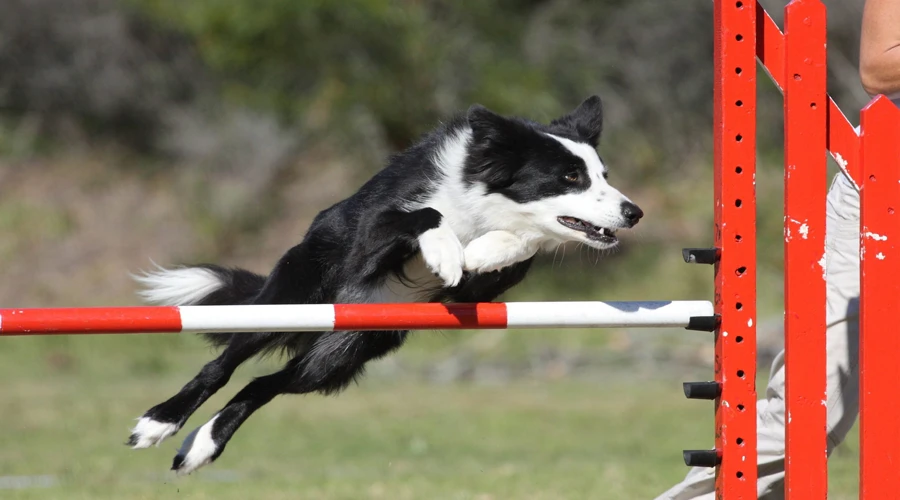Is your canine athlete slowing down? It could be dog arthritis.
Does your dog limp after agility practice or struggle to jump for targets that used to be easy? These could be early signs of dog arthritis, a condition that can sideline even the most competitive canine athletes.
Canine sports like agility, flyball, tracking for search and rescue, dock jumping, disc dog, earthdog, and field trials, along with many others are fun and rewarding for both dogs and their parents. But these high-impact activities can put a lot of wear and tear on your dog’s joints.
Canine athletes must be fast, agile, and flexible, not only during competition but also throughout the many hours of necessary training. The physical demands can make these dogs more likely to develop dog arthritis, also known as canine osteoarthritis (OA), with signs of the disease often starting in young, otherwise healthy animals.
Know the signs of dog arthritis in your canine athlete
It can be easy to overlook the signs of dog arthritis because dogs are good at hiding pain until it becomes debilitating. And, in the case of canine athletes, they are often willing to push past any pain they feel when they are engaged in the thrill of the chase. But they often pay the price later on from working their bodies so hard.
There are some key signs of early OA to be aware of in your canine athlete. These can provide clues that help in identifying dog arthritis before it gets so bad that your dog can no longer take part in the sport you both enjoy. Are you seeing signs such as:
- Favoring a particular leg while performing certain tasks
- Having less power in his or her ability to take off
- Knocking down more bars or missing more targets
- Having increasingly slower course times or missed contacts
- Limping after resting following a competition or training session
- Exhibiting mild muscle tremors following exertion
Understand how dog arthritis damages the joints
Dog arthritis is caused by a vicious cycle that begins when the tissue that lines the joint(s) becomes inflamed as a result of all that jumping, leaping, and running.
Your dog’s immune system then overreacts and begins producing certain substances that damage the protective lining of the joint bones (called “cartilage”), resulting in the pain and disability of OA.
There are 4 stages of dog arthritis to be aware of and why you should talk to your veterinarian as soon as possible once you begin noticing any signs that could be OA.
- Stage 1. Your dog’s joint is still normal but he or she may have 1 or more risk factors. In the case of the canine athlete, simply participating in regular, high-impact activity is a risk factor
- Stage 2. Mild dog arthritis is visible by X-ray. Your dog is still able to compete but may be showing the first signs of the disease, like joint swelling or stiffness
- Stage 3. At this point, dog arthritis has progressed to the point where there are readily noticeable symptoms, and your dog is no longer able to compete at the same level as before
- Stage 4. By stage 4, dog arthritis has become so severe that your dog is no longer able to get around normally. He or she may have trouble even getting up after lying down and may have very little interest in going on gentle walks let alone participating in intense exercise
Talk to your veterinarian as soon as you suspect dog arthritis
It’s important to discuss any signs of dog arthritis with your veterinarian, who will want to do a workup to diagnose and begin treating the condition as early as possible. He or she will:
- Review your dog’s medical history, such as past injuries and when you started seeing signs of suspected OA
- Check the joints for fluid accumulation, swelling, redness, and warmth
- Perform an X-ray which will show if OA is present
- Order an MRI or CT scan to get a clearer view of what’s happening inside your dog’s joint(s)
Common treatments for dog arthritis include daily pills and chews, or monthly injections. While these drugs are effective pain relievers, they work by just masking pain signals but can’t effectively address the inflammation that’s causing the joint damage.
And, if only the pain is managed but not the inflammation that’s causing it, dog arthritis can progress to the point where typical pain relievers no longer work.
Ask about Synovetin OA® for up to 1 full year of pain relief with 1 treatment
Synovetin OA is a completely different arthritis treatment that acts on the driver of the disease itself—inflammation—not just symptoms. All it takes is a single, simple treatment.
After being injected into the joint, Synovetin OA goes to work, right where it’s needed to reduce inflammation. This can help restore joint health at any stage of arthritis, but sooner is always better, especially in the case of the canine athlete.
What’s more, Synovetin OA doesn’t spread throughout the entire body like medications do, which can cause side effects. It’s a safe, effective approach to dog arthritis that gives up to 1 year of pain relief and has the potential to delay further joint damage by reducing the inflammation that causes it.
Read more about how 1 simple treatment with Synovetin OA works to give your dog up to 1 whole year of pain relief.




